| Author |
Message |
|
Luke Royle
|
 Posted: Mon 10 Aug, 2015 12:44 pm Post subject: Using a modern ash dowel for a spear shaft? Posted: Mon 10 Aug, 2015 12:44 pm Post subject: Using a modern ash dowel for a spear shaft? |
 |
|
Is a ash dowel suitable to be used for a spear shaft? I've looked around for something to use as a spear shaft for a while, and the only thing that I could find was a large 7 ft ash dowel. Is it possible to make dowels look more historically accurate, and how does one achieve this?
Many thanks.
|
|
  |
 |
Dan Howard

|
 Posted: Mon 10 Aug, 2015 1:56 pm Post subject: Posted: Mon 10 Aug, 2015 1:56 pm Post subject: |
 |
|
The best spear shafts are cut from saplings or coppiced branches that are only a little larger than the final diameter of the shaft. That way you get the most optimal grain alignment plus the sapwood and heartwood are both present. Modern dowels aren't an ideal substitute because they are cut from much larger trees. The strength and flexibility won't be as good.
Author: Bronze Age Military Equipment, Pen and Sword Books
|
|
  |
 |
Matthew Bunker

Location: Somerset UK Joined: 02 Apr 2009
Posts: 483
|
 Posted: Mon 10 Aug, 2015 2:32 pm Post subject: Posted: Mon 10 Aug, 2015 2:32 pm Post subject: |
 |
|
| Dan Howard wrote: | | Modern dowels aren't an ideal substitute because they are cut from much larger trees. . |
As were the shafts for thrusting spears in the early medieval period (at least in North Western Europe).
A recent study of wood remains in spear heads from weapons burials has shown that coppiced wood was used for what are assumed to be throwing spears and planked wood was used for the heavier thrusting spears.
This shows a continuity of tradition, because the same can be seen in the spearshafts recovered from the Danish bog deposits of the 3rd-5th century.
As such, if it's for a heavier spear rather than a javelin, I think that ash dowel is not a bad place to start.
"If a Greek can do it, two Englishman certainly can !"
|
|
  |
 |
|
Geoff Wood
|
 Posted: Mon 10 Aug, 2015 3:54 pm Post subject: Posted: Mon 10 Aug, 2015 3:54 pm Post subject: |
 |
|
| Matthew Bunker wrote: | | Dan Howard wrote: | | Modern dowels aren't an ideal substitute because they are cut from much larger trees. . |
As were the shafts for thrusting spears in the early medieval period (at least in North Western Europe).
A recent study of wood remains in spear heads from weapons burials has shown that coppiced wood was used for what are assumed to be throwing spears and planked wood was used for the heavier thrusting spears.
This shows a continuity of tradition, because the same can be seen in the spearshafts recovered from the Danish bog deposits of the 3rd-5th century.
As such, if it's for a heavier spear rather than a javelin, I think that ash dowel is not a bad place to start. |
But then, planks were cut (or at least could be cut) differently then than now, in that they followed the grain more (split rather than sawn) so they would, like coppiced wood, avoid the risk if grain splitting across, rather than along, their length (e.g. see flexibility of planks used in 'longships' that could flex with waves). That said, I've used dowel myself for spear shafts.
Geoff
|
|
  |
 |
Dan Howard

|
 Posted: Mon 10 Aug, 2015 5:27 pm Post subject: Posted: Mon 10 Aug, 2015 5:27 pm Post subject: |
 |
|
I never said that modern dowels couldn't be used for spear shafts. I am suggesting that they won't be as strong or supple as shafts made in a traditional manner using coppiced timber or split planks..
Author: Bronze Age Military Equipment, Pen and Sword Books
|
|
  |
 |
|
Ben Coomer
|
 Posted: Mon 10 Aug, 2015 5:43 pm Post subject: Posted: Mon 10 Aug, 2015 5:43 pm Post subject: |
 |
|
I've used ash dowels for my spears and they are fine.
Branches or saplings probably would be better, but they aren't nearly as easy to come by.
|
|
  |
 |
|
Matthew Amt
|
 Posted: Mon 10 Aug, 2015 7:19 pm Post subject: Posted: Mon 10 Aug, 2015 7:19 pm Post subject: |
 |
|
If you have an ash pole, use it! If you find something better for your *next* spear, even better.
It's quite likely that your dowel is too thick, for starters. The 7-foot poles that I've seen available tend to be 1-1/4" in diameter, and the spearshafts that I'm familiar with (mainly ancient) are mainly an inch or less. Some are tapered as well, depending on where you want the balance.
Get a rasp and get to work! A drawknife will take wood off more quickly, but if you aren't practiced with it, it's a little easy to rip off a deeper chunk than you wanted. Rasps are slower but completely safe, in that regard. What you end up with will probably not be completely round or perfect, unless you're more patient than me, but that's fine! Once the shape is in the ballpark, sand it to taste.
Last year I had a local specialty wood store slice me a c. 2-1/2" wide piece of "8 quarter" (2 actual inches thick) ash, for making the bottom half of a pike shaft. I discovered that working with square lumber was wonderful, because I could simply draw lines for the taper I wanted, and cut with a saw. Then an electric hand planer knocked the corners off, and some rasping and belt sanding finished it up. You can't draw guidelines like that on a dowel. I'll actually get a total of 4 shafts from that piece of wood, plus some shorter pieces that might do axe handles!
Unfortunately, all the little trees in my yard that need to come down are cedar and mulberry...
Have fun! Make spears!
Matthew
|
|
   |
 |
|
Carl W.
|
 Posted: Tue 11 Aug, 2015 7:19 am Post subject: Posted: Tue 11 Aug, 2015 7:19 am Post subject: |
 |
|
| Matthew Amt wrote: |
Last year I had a local specialty wood store slice me a c. 2-1/2" wide piece of "8 quarter" (2 actual inches thick) ash, for making the bottom half of a pike shaft. I discovered that working with square lumber was wonderful, because I could simply draw lines for the taper I wanted, and cut with a saw. Then an electric hand planer knocked the corners off, and some rasping and belt sanding finished it up. You can't draw guidelines like that on a dowel. I'll actually get a total of 4 shafts from that piece of wood, plus some shorter pieces that might do axe handles!
Matthew |
Thanks for posting this. I had thought about making a few spear shafts from an ash plank but procrastinated, rather let someone else find out if it was a good idea or too much work :)
What taper? Also if you really meant 2.5"x2" then to get 4 shafts are they "too thin" after all the cutting & removal work? I was thinking thicker, ~1.125" for viking, perhaps wrongly.
|
|
  |
 |
|
Luke Royle
|
 Posted: Tue 11 Aug, 2015 8:06 am Post subject: Posted: Tue 11 Aug, 2015 8:06 am Post subject: |
 |
|
| Matthew Amt wrote: | If you have an ash pole, use it! If you find something better for your *next* spear, even better.
It's quite likely that your dowel is too thick, for starters. The 7-foot poles that I've seen available tend to be 1-1/4" in diameter, and the spearshafts that I'm familiar with (mainly ancient) are mainly an inch or less.
|
Many of the spear heads that I've looked at appear to have a socket that has a width of above 1 inch. I've found a nice looking spear head from MedievalShoppe that is 3.3cm wide at the socket, I plan on buying a dowel that is only a few milometers larger and shaving it down to a taper to fit the head.
|
|
  |
 |
|
Matthew Amt
|
 Posted: Tue 11 Aug, 2015 8:46 am Post subject: Posted: Tue 11 Aug, 2015 8:46 am Post subject: |
 |
|
Ah, yes, modern reproduction spearhead sockets are often an inch or more. Originals of that size do exist, but it really looks like the vast majority were smaller. But you need scale drawings or some decent lists of measurements to be sure, and I've never really looked that up for medieval spears.
You *do* want your shaft to fit the head you have! Sometimes you can cut an inch or so off the bottom of the socket to reduce the maximum diameter.
Greek thrusting spears do seem to have been thinner at the point than at the butt. This helped move the balance point as far back as possible. I *suspect* that javelin shafts were the opposite, needing to have their balance point farther forward, and being a little thinner overall. Of course there were also spears meant for both thrusting and throwing, so I can only guess they'd be best with a more central balance point.
Pikeshafts definitely taper, so from my original piece I cut off two tapered lengths. The narrower ends were indeed a bit thin! So I just cut that part off. (The piece was over 10 feet, so I had to lop off 3 or 4 feet in any case.) My two finished throwing spears are about 3/4" diameter at their thinnest. Ah, here--the piece of ash, shown with the regular dowel that I used for the upper half of the pikeshaft:
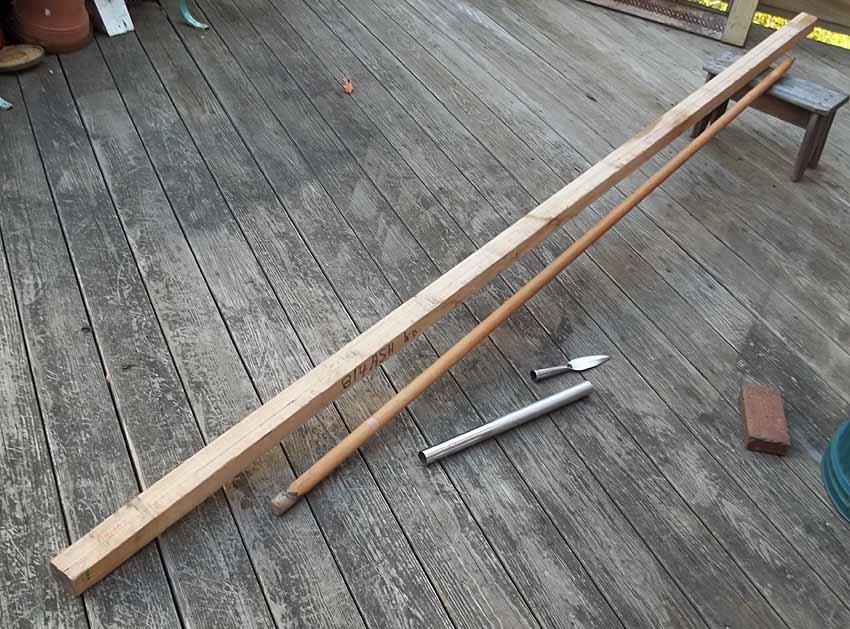
Then after the first two cuts, the pikeshaft now has the dimentions that I want, and just needs to be rounded. The two "offcuts" are at left, and the wider one will be cut down the middle to make 2 shafts.
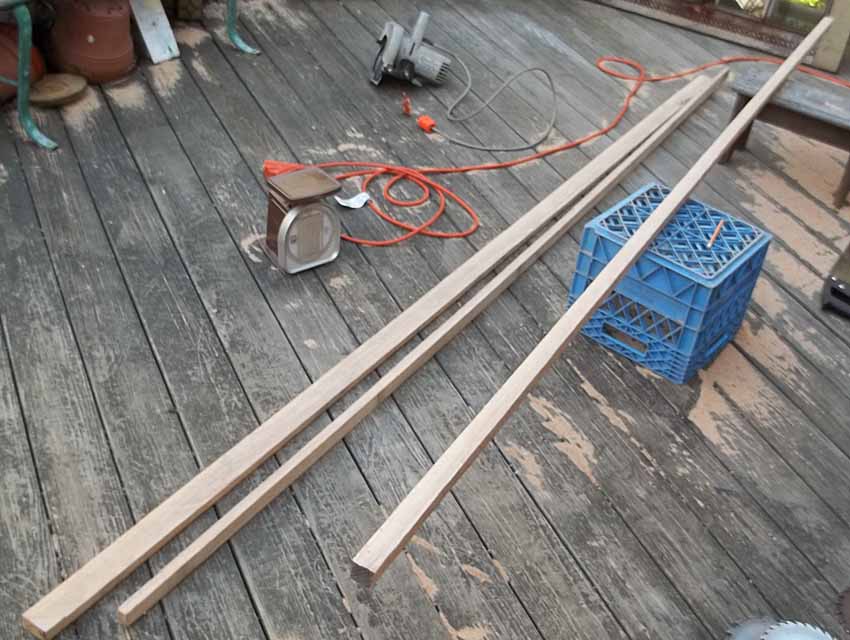
Here's the pikeshaft after roughly "rounding" it with the electric planer, and the dowel has been reduced and tapered the same way.
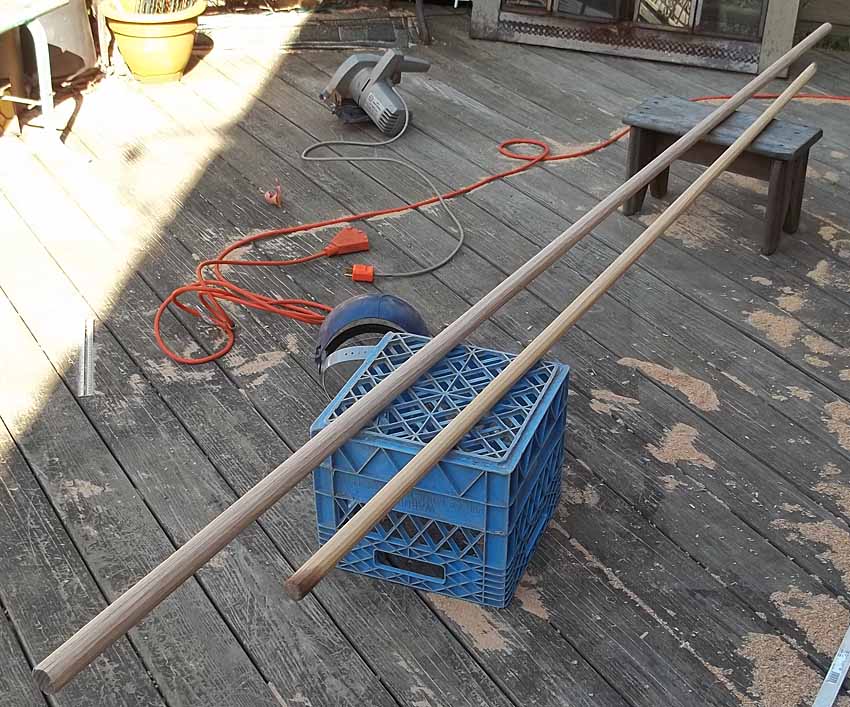
This really didn't take very long! I LOVE my electric planer, but you have to be a little careful with it to avoid going too deep.
Matthew
|
|
   |
 |
Matthew Bunker

Location: Somerset UK Joined: 02 Apr 2009
Posts: 483
|
 Posted: Tue 11 Aug, 2015 2:34 pm Post subject: Posted: Tue 11 Aug, 2015 2:34 pm Post subject: |
 |
|
| Luke Royle wrote: | | [shaving it down to a taper to fit the head. |
Early medieval spear shafts weren't just tapered. They were also shouldered, so that there was a smooth run from the shaft onto the socket.
Where the head has a split rather than a closed socket, the shaft was cut so that it fitted into the split of the socket.
"If a Greek can do it, two Englishman certainly can !"
|
|
  |
 |
Dan Howard

|
 Posted: Tue 11 Aug, 2015 3:04 pm Post subject: Posted: Tue 11 Aug, 2015 3:04 pm Post subject: |
 |
|
My last few spear shafts were made with just a sharp machete and sandpaper. I'm starting to get my eye in and it takes a while to get used to working with the machete but the last one turned out almost as nice as if I used power tools.
Author: Bronze Age Military Equipment, Pen and Sword Books
|
|
  |
 |
J. Nicolaysen

|
 Posted: Tue 11 Aug, 2015 4:53 pm Post subject: Posted: Tue 11 Aug, 2015 4:53 pm Post subject: |
 |
|
Hey nice thread.
I recently got three forged spear heads from a blacksmith that I need to mount. Thirty dollars each, I think they will make acceptable javelins.
So I bought a shovel handle for one and am planning to plane for another and see which one is best. Maybe I will try Dan's Machete Method for the third. If it's interesting I hope to post later. Lucky for me Woodworkers Supply has a warehouse nearby. http://woodworker.com/
But thanks for these tips and any others I will be interested to hear.
 Attachment: 156.82 KB Attachment: 156.82 KB
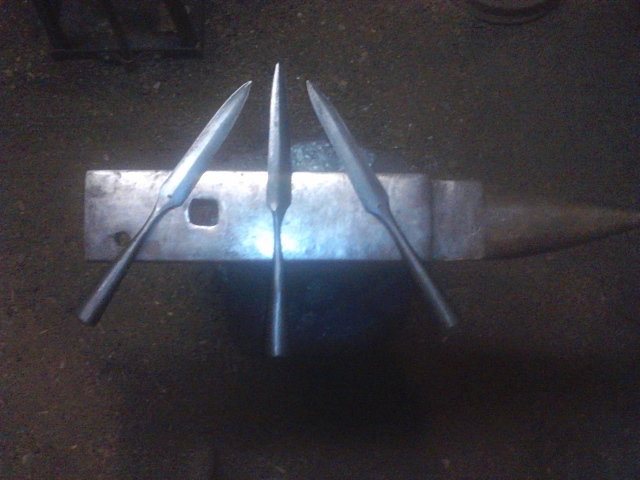
|
|
  |
 |
|
Kel Rekuta
|
 Posted: Tue 18 Aug, 2015 12:39 pm Post subject: Posted: Tue 18 Aug, 2015 12:39 pm Post subject: |
 |
|
We became exasperated with the constant breakage of spear and pollaxe hafts in our training. I got an order for several "select" lance shafts in ash from a 1812 re-enactment group. Since I was setting up for them, I decided to run a batch of staves for us too.
I bought a couple hundred board feet of select 8/4 ash and did what some of the others did. I was very particular to only cut quartered grain for this project, leaving the rest for chair and stool parts. I've put more than a dozen spears into use and not a single one has split let alone break in two years of hard use. Aside from coppiced staves, I think quartered grain staves are about as good as we can get these days.
I don't agree that one inch diameter spear shafts were all that common for medieval spears 6-7" long. In armoured combat, they just bend and snap. An extra 1/8th or preferably 1/4" seems to make them more manageable and less flicky.
|
|
   |
 |
|
Andrew W
Location: Florida, USA Joined: 14 Oct 2010
Posts: 79
|
 Posted: Mon 14 Sep, 2015 5:14 am Post subject: Posted: Mon 14 Sep, 2015 5:14 am Post subject: |
 |
|
I'm getting in on this late, my apologies.
Regarding the question of sapling vs. mature timber, it really seems to depend on the species of wood being used. I've been building a database of 5-7th century Anglo-Saxon spears, and 80% of the ash spears were made from mature timber cut down to size. Hazel, in contrast (the second most common species) was more frequently used as a sapling (64%). Willow / poplar was also preferred as a sapling rather than mature timber (80%), as were beech, maple, and holly (the last three were relatively uncommon shaft choices).
In the case of hazel, this must be partly due to the fact that Hazel doesn't grow very large, so there's less option to carve down planks. But ash, like hazel or maple, is easy to coppice into straight shafts without bothering to cut down a larger plank, so there seems to have been a clear preference for the physical properties of mature ash in some circumstances.
For smaller spearheads, the kind that could work as javelin or hand-held weapon, there's no discernable preference for mature ash or hazel saplings, but for longer spearheads there's a clear preference for mature ash over all alternatives.
Here's a breakdown (this is just for spears from 5-7th century Anglo-Saxon inhumations):

I don't think it's entirely clear from this data that saplings == javelins (unless we assume all short spearheads are for throwing), but it definitely seems to be true that larger spearheads, which would be awkward as javelins, benefitted from the physical properties of mature ash timber.
And the diameter of the outside of the socket for spears from this period is 20.0mm for ash (n=89), 18.8mm for hazel (n=50), and 20.0mm for poplar/willow (n=26). The average for all the sockets I've been able to measure (regardless of whether the shaft species can be identified) is 16.9mm (n=536). Assuming the shafts didn't taper wider beneath the head, this suggests shaft diameters well under 1" (and surviving ferrules suggest that spears generally tapered narrower toward the base, though that doesn't preclude a shaft that is widest in the middle and narrower on each end).
My question for those with more experience would be whether the way in which the ash is trimmed down to a dowel matters. A generic modern dowel is often turned from a shaft with little regard to the grain, and I've seen them split at weird angles. I assume that a shaft cut with a draw knife from carefully selected split (rather than sawn) timber would be stronger because it would be more likely to have the grain running the entire length of the pole (and Geoff's and Kel's posts suggest this is true). Is this important, or does following the grain not matter that much in the end?
|
|
  |
 |
|
Matthew Amt
|
 Posted: Mon 14 Sep, 2015 6:56 am Post subject: Posted: Mon 14 Sep, 2015 6:56 am Post subject: |
 |
|
That's great stuff, Andrew, thank you very much! I know I've seen figures sort of like that before, but it's still a little surprising seeing all the numbers laid out. Everything is so tiny! Just fascinating. Cool chart, too!
Matthew
|
|
   |
 |
|
Jeffrey Faulk
|
 Posted: Mon 14 Sep, 2015 9:35 am Post subject: Posted: Mon 14 Sep, 2015 9:35 am Post subject: |
 |
|
Minor point of order-- you don't split billets of wood with a drawknife, that's not what that's for. You use a tool called a 'froe', or you use a splitting wedge. The froe has the advantage in that by levering its handle back and forth you can direct the split to some degree, a little more predictably than with the wedge. The drawknife is for rough and fast shaping of the blank.
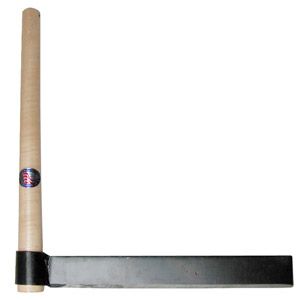
Sawing them out is a bit safer, but obviously won't follow the grain. If you're careful, you can try to follow the grain by eye; some lines drawn along the grain direction can help. Ash (if you're using that, anyway) does have fairly prominent grain lines so that would help.
|
|
  |
 |
|
|
You cannot post new topics in this forum
You cannot reply to topics in this forum
You cannot edit your posts in this forum
You cannot delete your posts in this forum
You cannot vote in polls in this forum
You cannot attach files in this forum
You can download files in this forum
|
All contents © Copyright 2003-2025 myArmoury.com — All rights reserved
Discussion forums powered by phpBB © The phpBB Group
Switch to the Basic Low-bandwidth Version of the forum
|

